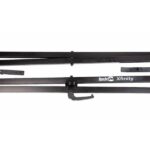Many beginner clarinetists encounter buzzing sounds when they start with their clarinet.

Though clarinets are exceptionally versatile and beautiful musical instruments, this buzzing sound could be frustrating.
This can turmoil your experience and effects overall musical performance.
Thus, knowing why your clarinet is buzzing and how to fix them is crucial for any clarinetist.
A clear and bell-like tone is the dream of every clarinet player, but buzzing can disrupt the beauty of your instrument.
From loose ligature to incorrect assembly, multiple factors contribute to this.
This article will explore these factors. And after uncovering these reasons, we will also provide practical solutions to rectify the problem.
So, if you’ve ever wondered, “Why is my clarinet buzzing?” and want to learn how to fix it, read on to discover the insights and remedies.
Contents
- 1 Reasons for Clarinet Buzzing
- 1.1 Mouthpiece Placement and Embouchure Issues
- 1.2 Addressing Mouthpiece Issues
- 1.3 Loose and Worn-Out Ligature and Reed
- 1.4 Resolving Ligature and Reed Issues
- 1.5 Air Leaks in the Clarinet
- 1.6 Addressing Air Leaks
- 1.7 Incorrect Assembly of Keys
- 1.8 Buzzing Due to Moisture
- 1.9 Removing Moisture from Clarinets
- 2 The Final Notes
Reasons for Clarinet Buzzing
Encountering buzzing while playing the clarinet is definitely not welcome.
This appears as an unwanted and frustrating guest making your experience unpalatable. The main reasons for clarinet buzzing include:
- Mouthpiece placement and embouchure issues.
- Loose and worn-out ligature and reed.
- Air Leaks in the clarinet.
- Incorrect assembly of keys.
- Moisture issues.
Fixing the clarinet buzzing requires a systematic approach and can be resolved with a few simple adjustments and maintenance practices.
However, it’s important to understand their reasons for resolving the clarinet buzzing issues effectively.
Below is a detailed discussion of the reasons for clarinet buzzing and its solutions.
Mouthpiece Placement and Embouchure Issues
The clarinet’s sound and tone depend highly on the mouthpiece, making it a crucial part of the clarinet.
Generally, Mouthpiece consists of four parts, the chamber, tip opening, facing curve, and baffle.
When a mouthpiece is poorly placed, it disrupts airflow and causes buzzing.
This means if the mouthpiece is pushed too far or too near, this can result in unwanted vibrations or air leakage respectively. This ultimately translates into buzzing.
The other buzzing issue related to mouthpieces is faulted embouchure techniques.
Embouchure is adjusting facial muscles, lips, and jaws accordingly with the mouthpiece.
An imbalanced placement leads to uneven distribution of pressure, ultimately causing buzzing.
Addressing Mouthpiece Issues
It’s important to master the fundamentals of mouthpiece positioning and embouchure placements.
This will not only gives a buzzing-free clarinet but also offers more control over tone, intonation, and overall performance.
Below are some general step-by-step guidelines to address mouthpiece and embouchure issues.
Check for loose parts: Start with inspecting for loose parts, as sometimes, not properly secured reed or ligature can cause buzzing.
Ensure every screw is tight, holding the reed and ligature around the mouthpiece.
Clean your mouthpiece: Accumulated dirt and debris can affect sound quality making regular cleaning necessary. Using a soft cloth with warm water is recommended.
However, for more effective results, add a small amount of dish cleaning liquid to the water.
Examine the facing: The mouthpiece facing is its curve touching the reed. Uneven or damaged facing may cause buzzing.
Gently run your finger along the surface, and in case you notice any bumps or rough spots, it’s recommended to consult a repair technician.
Check your embouchure: The more balanced and flexible embouchure, the better the sound quality will be.
An effective embouchure includes proper lip pressure, unevenly distributed air pressure through the reed, and avoiding excessive tension.
To promote embouchure, practice lip slur that helps develop strong and controlled embouchure.
Mouthpiece placement: Improper positioning can also be a cause of buzzing. Align the tip of the reed with the tip of the mouthpiece.
Ensure that the tip of the reed is resting just below the lower lip. Further, experiment with different positions to find the sweet spot.
Loose and Worn-Out Ligature and Reed

Whether you are a beginner or a professional, you will surely know the importance of ligature positioning and reed placement in clarinet sound production.
Ligature is usually composed of metal or fabric adjusted with screws. They help to keep the reed in place at the mouthpiece—untight ligature results in reed vibration.
These reed vibrations interfere with the clarinet’s air column, producing buzzing and distorted sounds.
While talking about reeds are made from a grass called Arundo Donax and can be considered as the most sensitive part of a clarinet.
You will hardly encounter any clarinetist happy with their reed. With time reed is worn out and loses its flexibility.
Ultimately worn-out reed cannot align itself with tone commands and produce buzzing and dull sounds.
Resolving Ligature and Reed Issues
Usually, it’s easy to play lower notes on a clarinet. But inappropriate sounds like buzzing could be a big issue when it comes to higher notes.
Here are some points to tackle clarinet buzzing resulting from loose ligatures and worn-out reeds.
Check ligature placement: Improper ligature positioning ends up with uneven pressure on the reed, eventually causing buzzing.
Ensure the ligature has its screws tight and properly aligned with the mouthpiece.
Try small variations in ligature positioning to find the optimal point that is secure yet provides balanced pressure on the reed.
Inspecting the reed: Using high-quality reeds with good health is important for quality sound production. Replace the worn-out weeds with new or relatively good-condition reeds.
Additionally, the too-soft or too-hard reed can cause buzzing. Try variations in reed strength to find which one best suits your embouchure and playing preferences.
Reed positioning: An unevenly aligned reed may not vibrate properly, thus causing buzzing and muffled tones.
Ensure the reed is covering the tip of the mouthpiece without extending too far or being too far back.
Rotate and Break-in reeds: Some time frame is required for a reed to show its full potential.
It is recommended to use multiple reeds in your practice sessions to make them adapt accordingly to your playing style.
Gradually breaking new reeds can help minimize buzzing caused by stiff or unresponsive reeds.
Additionally, regularly rotate the position of the reed on the mouthpiece to ensure even wear and promote longevity.
Air Leaks in the Clarinet
Air leaks in the clarinet can be a major cause of buzzing and can significantly impact the instrument’s overall tone quality.
Thus it’s crucial to understand various points for air leaking to address the buzzing problem effectively.
The most common part of air leaks in clarinet includes tenon joints (connection points between various parts of the clarinet), keypads, tone holes, and cracks in the instrument.
The air leaks affect smooth airflow and result in uneven air pressure distribution.
This is followed by buzzing and vibrations, ultimately affecting the overall quality of the tone.
Addressing Air Leaks
From properly aligning tenon joints to inspecting cracks for air leaks and maintaining functional keypads, various measures are required to address the buzzing due to air leaks effectively.
Below are important considerations to address air leaks from the clarinet.
Visual Inspection: Start with visual inspection and try to locate gaps, cracks, and loose fittings. Additionally, check the joints, tenons, key mechanisms, and tone holes for damage and misalignment.
Use of Teflon tape or cork grease: Tenon joints are primary sources of air leaks. To eliminate air leaks from tenon joints, they may require little maintenance, like Teflon tape or cork greasing.
Apply a thin layer of Teflon tape to the tenons and joints to create a snug fit. Similarly, applying cork grease to the cork tenons can help fill small gaps and improve the seal.
However, these are temporary measures, and it is advisable to consult a professional repair technician for a permanent solution if the leaks persist.
Adjusting key corks: Inspect the keypad for whether they create air-tight seals or not when closed.
Check for signs of wear, damage, or deterioration and replace any damaged keypads.
Using cigarette paper method for detecting air leaks: A reliable method for detecting air leaks is the cigarette paper method.
Add a small piece of cigarette paper or other thin, lightweight paper between the tone holes and the pads.
Gently close the keys over the paper and try to pull it out. If the paper slides out easily without resistance, it indicates an air leak.
Identify the specific keys or pads that are causing the leaks and consult a repair technician to address the issue.
Incorrect Assembly of Keys

Incorrect assembly or improper adjustment of keys can be another underlying cause of clarinet buzzing.
Keys are an important part of the clarinet as they seal tone holes and help produce the required sound.
If keys are not well aligned, this could result in air leakage and vibrations leading to buzzing.
Understanding how misalignment or faulty key adjustments can contribute to buzzing is essential for maintaining a well-functioning instrument.
The misalignment of keys could be due to various factors, including improper assembly or disassembly, bent or damaged keywords, or general wear and tear.
To address these issues, below given are some general guidelines.
Furthermore, for proper assembly and disassembly of keys, notes by the Woodwind workshop can be effectively helpful.
Understand Key alignment: Each key on your clarinet has a specific function and acts in a specific way.
Thus it’s important to understand their proper alignment for minimizing buzzing.
For this, get help from your clarinet’s manual or seek guidance from a professional and experienced player.
Ensure correct spring tension: Each key in your clarinet has a spring, making them return to its original position.
Fault in spring tension cause key sticking, eventually resulting in buzzing.
Thus to minimize buzzing, ensure springs are correctly positioned and properly tensioned.
Key Height and Levelness: Incorrect key heights can lead to buzzing or inconsistent tone quality, making them crucial for a well-assembled clarinet.
Ensure that the keys are level and have uniform spacing when in the closed position.
Buzzing Due to Moisture
Depending on their manufacturing material, clarinets are usually available in brass and woodwind instruments.
Unlike the brass, the woodwind doesn’t have any spit valves.
Thus in these clarinets, there are chances of moisture built up in joints, mouthpiece, and barrel. This moisture could be another reason for the buzzing clarinet.
Removing Moisture from Clarinets
In the case of moisture, two approaches can effectively help to curtail buzzing. These include:
Preventing moisture entry: Consider using a moisture barrier to prevent excessive moisture from entering your clarinet.
A moisture barrier, such as a mouthpiece patch or pad, is placed on the top of the mouthpiece to absorb moisture from your breath.
It helps to minimize the amount of moisture that reaches the inside of the instrument, reducing the risk of buzzing caused by excess moisture.
Removing moisture: To remove moisture from your clarinet, all you are required to do is take a swab and clean the instrument.
A clarinet swab is a cloth or silk string with a weighted end that is pulled through the instrument to remove moisture.
Start by removing the mouthpiece and barrel, then gently insert the swab through the upper joint, lower joint, and bell.
Ensure that the swab passes through all the curves and keys to absorb moisture effectively.
While doing so, ensure that the reed is removed and assembly of all parts is air-sealed after moisture removal.
The Final Notes
Clarinet buzzing is indeed frustrating, but understating its reason can be a way forward.
To eliminate buzzing from your clarinet, understand its reasons and apply effective strategies.
The article has explored various factors that contribute to clarinet buzzing.
They include inappropriate mouthpiece placement, loose ligatures, air leaks, reed issues, and incorrect assembly.
By addressing these factors through proper techniques, clarinetists can overcome buzzing challenges and produce a clear, resonant tone.
Regular maintenance and attention to detail are key to preventing buzzing issues.
With diligence and practice, clarinetists can enjoy the full potential of their instrument and play with confidence.






